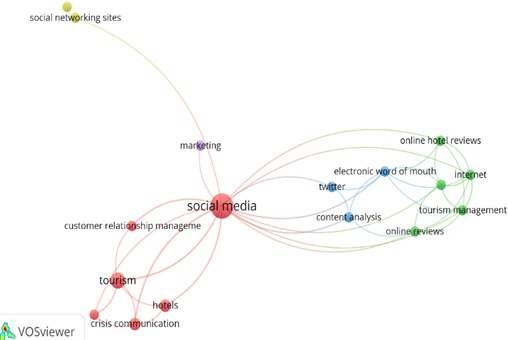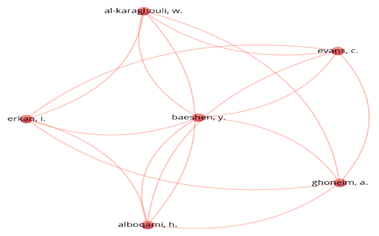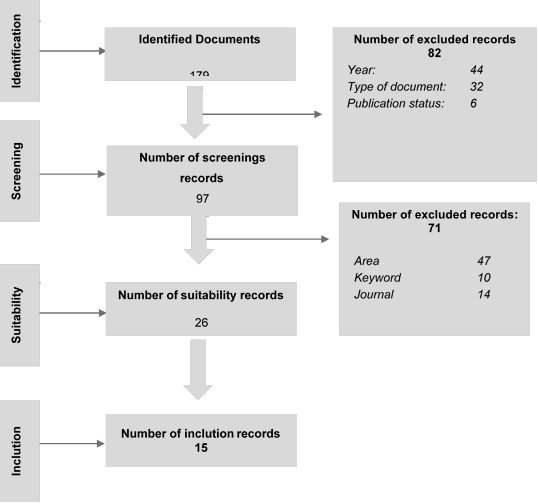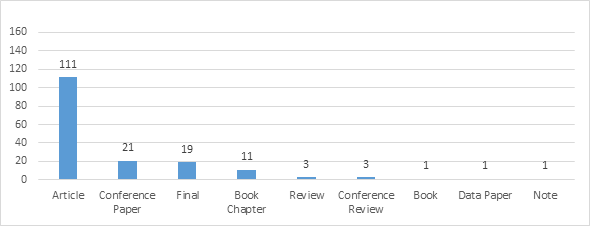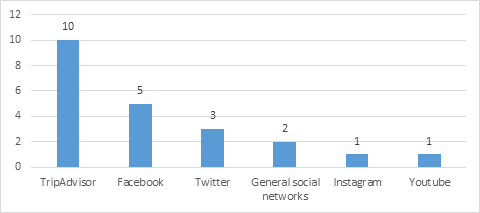1. Introduction
In recent years, the tourism industry has undergone important transformations related, particularly, to the emergence and improvement of information and communication technologies (Shankar & Hampesh, 2023). Among the most significant changes for the sector are the emergence of the Internet and the development of social networks. With the emergence and subsequent development of social networks, interaction among users has increased, turning them into current business models in the sector will be forced to make the necessary changes to meet the needs of more connected consumers (Abbasi et al., 2023)
For the tourism cluster, social networks have become the platform where tourists and travelers share their experiences with other people through the use of stories, photos, comments and videos. In this sense, platforms such as Facebook, Tripadvisor, Instagram have taken great relevance and importance for companies in the sector (Albacete & Herrera, 2012). The above highlights the relevance of social networks in the transformation of companies that communicate with their real and potential customers (Sicilia, 2022).
According to data from We are social and Hootsuite (2023), the number of internet users corresponds to 4,950 million people, representing 62.5% of the world population (7,910 million people), and the number of registered social networks is 4,898 million, with a total of 13,100 million connected devices worldwide. In Colombia, 69% of the total population of the country is an active user in social networks, that is, by January 2020 around 38 million people use social networks" (Branch, 2020) and, according to data from ComScore (2019) of every 10 people with a profile on some network, eight Colombians are active (Lopez, 2019), with Facebook being the social network with the most users, achieving 2.271 million users in 2019. In addition, it is above other digital platforms such as YouTube, Instagram, Twitter or LinkedIn (We Are Social, 2023).
This study aims to establish the use of social networks in companies in the tourism sector, especially to identify the most popular networks, their type and the role they play in these companies. The problem was approached through a systematic literature review, focused on the use of social networks in tourism companies. Next, the main concepts about social networks, their classification and importance are presented. Then, the methodology applied is described, the findings of the study are presented and the conclusions of the research are given.
2. Methodology
2.1 Basic concepts
Social networking
The web 2.0 or social web allows the connection of communities with common interests, which facilitates bidirectional interactions between users, interactions that are the basis of social networks (García et al., 2022). The term social network originated before the emergence of the internet and the platforms observed today (Kuz et al., 2016). Initially, the term social network referred to the ties existing in kinship groups, mainly in families that form a network where all family members, parents, their relatives and friends are found (Hariri & Anbari, 2022). Disciplines such as sociology, anthropology, philosophy, sociolinguistics or mathematics have been devoted to the study of social networks, having as a common element the individual and the personal relationships that he or she establishes with the rest of the group (Otero-Gómez & Giraldo-Pérez, 2023; Hernández-Suarez et al., 2022).
Social networks can be understood as an online medium that functions as a mass communication tool, which facilitates beneficiaries to build a profile and create a community or groups on the internet (Rodríguez-Herráez et al., 2017). Takyiakwaa (2019), defines a network as "a particular set of interrelationships between a limited set of individuals; these network interrelationships can be used for the interpretation of the social behavior of those individuals. In this sense, social networks constitute a variable number of nodes, which may be subjects or organizations, linked to other nodes, defined as information exchange agents (Ruiz-Bolivar, 2016). On the other hand, Pérez (2015), considers social networks as: "tools designed to create spaces to promote and facilitate the conformation and development of communities through social exchange.
Virtual social networks can be conceived as a web service located on the Internet, which facilitates people to engage in real-time or delayed communication with other people, acquaintances and strangers from different social classes, cultures, religions and political ideas, in order to share all kinds of information, personal and professional (Sanchez & Tena, 2019).
Social networks can be classified into horizontal and vertical: the former are those where users join a large network with thousands of users, such as Facebook, Gnoss or Tuenti; vertical networks are created by the participants themselves and their users are united by a common interest (Sicilia et al., 2022). Authors such as Pertegal-Vega et al. (2019) classify social networks as follows: professional networks (LinkedIn, Xing, Viadeo), generalist networks (Myspace, Facebook, Tuenti, Hi5) and specialized networks (Ediciona, eBuga, CinemaVIP). For Sahoo & Gupta (2019), social networks can be classified according to their target audience and subject matter, the main subject of the relationship, geographic location, and platform type.
Turism
Tourism is understood as the human propensity to move from one place to another for pleasure or enjoyment (Morillo-Moreno, 2011). The World Tourism Organization (WTO, 2011), expands the scope of the concept by highlighting that tourism not only includes the movement of people to places other than their usual place of residence, whether for leisure, business, pleasure or any other reason, as long as it is for a period of less than one year; it also includes the activities carried out by these people in the places to which they move.
The tourism and lodging sector is highly relying on social media because, like any other service sector, it sells products that are intangible (Gutiérrez-Montoya et al., 2018). Social networks and other ICT-related tools have changed the way people carry out the process of informing, planning, booking and living their tourism experiences (Echeverri-Sucerquia & Quinchía-Ortiz, 2023). The information shared through social networks is becoming fundamental for potential tourists to make decisions about everything related to their trip (Fontalvo et al., 2022). This has an impact not only on the way people schedule and carry out their trips, but also on the way companies market their services (Bolzán & Fernandes-Ferreira, 2020).
2.2 Method
In this research, the Preferred Reporting Items for Systematic reviews and Meta-Analyses (PRISMA) literature search method was applied, which guided the meta-analysis of scientific papers selected from the Scopus database (González-Calixto et al., 2023). The following search terms were defined: "social media" and "tourism" and "hotels"), which resulted in an initial filtering of 179 articles. The inclusion and exclusion criteria are shown in Table 1.
Table 1 Exclution and inclution criterias.
| Inclution | Articles published in the Scopus database |
| Articles published in the period 2015-2020 | |
| Articles published in English and Spanish | |
| Full research articles and systematic reviews | |
| Completed articles | |
| Exclution | Articles from health, technology, environment and marketing journals |
| Articles from the subjects: Environmental Sciences, Computer Sciences, Earth and Sciences, Arts and Humanities, Mathematics, Econometrics, Economics and Finance. | |
| Articles in Portuguese language | |
| Articles relating to hotel industry |
The documents were processed with Vosviewer software, which allows us to observe the relationships between the bibliographic networks of the authors and words of the scientific articles consulted (Figures 1 and 2).
After applying the inclusion and exclusion criteria, the number of documents was reduced to 26. These 26 articles were subjected to an individual analysis of the abstract and title to establish their direct relationship with the research objective, which finally yielded 15 articles suitable for processing (Figure 3).
The information was organized taking into account: year of publication, keywords, name of the journal, social network analyzed and its application. This information was synthesized and analyzed through a matrix created in Excel (Chajin-Florez, 2022).
3. Results and discussion
3.1 Identified documents
Among the findings, the type of document with the highest number of records in Scopus is articles (62%), followed by session documents (12.3%), while the categories: books, notes and data papers have the lowest participation (1%) in each one (Figure 4).
In relation to the publication of the selected articles for the period 2015-2020, it is observed in Figure 5, that, for the years: 2015, 2019 and 2020, the highest number of published articles was registered (6), respectively. And, the year 2017, was located with the lowest frequency of publication.
The selected articles appear in 22 journals, with the Journal of Travel and Tourism Marketing having the largest number of publications (3). Likewise, the journals Tourism Management and Advances in Hospitality and Tourism Research have two publications each while the other journals have only one publication.
3.2 Social network use
Figure 6 shows that TripAdvisor is the most used social network in the hotel industry, appearing in 10 of the 15 articles reviewed. This is followed by Facebook and Twitter with 5 and 3 mentions, respectively.
As for the role of social networks, the possibility for users to share their experiences, feelings, interests and opinions about the place where they have stayed is highlighted. The ability to interact with the hotel and to leave comments about the quality of the service is also highlighted. Table 2 describes the specific function of the social networks identified in the 15 articles analyzed.
Table 2 Social Media and their role according to selected articles.
| Author | Social Media | Function |
|---|---|---|
| Van Der Zee et al. (2020) | TripAdvisor | Posting Photos |
| Barbe & Pennington (2018) | Share experiences | |
| Chan et al. (2018) | Social Media in general | Share experiences |
| Dimitriou & AbouElgheit (2019) | Facebook, Instagram and TripAdvisor | Share experiences |
| Hidalgo-Downing (2020) | TripAdvisor | Share experiences |
| Schuckert et al. (2015) | TripAdvisor and Facebook | Share experiences |
| Ly (2020) | Social Media in general | Share experiences and reactions |
| Phillips et al. (2015) | TripAdvisor | Share experiences |
| Sánchez-Jiménez et al. (2020) | Facebook and Twitter | Interactions with hotels chains |
| Zazueta et al. (2018) | Share experiences | |
| An et al. (2020) | TripAdvisor | Share experiences |
| Uslu-Cibere et al. (2020) | TripAdvisor | Share experiences |
| Wang et al. (2015) | Facebook, Twitter, TripAdvisor and YouTube | Share experiences |
| Yilmaz (2019) | TripAdvisor | Share experiences |
Concerning the classification of social networks, Table 3 shows that TripAdvisor is defined as thematic and vertical, since it focuses on the tourism sector and manages a defined thematic axis. Likewise, Twitter and Facebook are horizontal, while Instagram and YouTube are content networks.
Table 3 Classification of social media in the tourism sector.
| Social Media | Classification | Characteristics | ||
|---|---|---|---|---|
| TripAdvisor | Themes | Specialized | Vertical | 2.0 service with social media feature |
| Horizontal | Generalists | Horizontal | Microblogging-based social media | |
| Horizontal | ||||
| >Content | ||||
| YouTube | 2.0 service with social media feature | |||
3.3 Discussion
The use of social networks in the hotel sector is mainly due to the fact that users share their experiences, criticisms and expectations during the process of selecting, booking and staying in a hotel. The interaction of potential clients with other users of the networks allows them to learn about the characteristics of the site and its service in general, so the conversation focuses on the positive or negative opinions that can be found on the web. The above contrasts with the studies of Ly (2020) and Varkaris & Neuhofer (2017), who mention that users use the networks to search for and identify benefits or advantages in the sites they are interested in visiting.
Social media has changed the way hotel users interact, research and make decisions about their accommodations. Social media has provided a platform for hotels to promote themselves, communicate directly with customers, and gather valuable feedback on their experiences. However, the networks also present challenges in terms of reputation management and responding to user feedback (Cascales et al., 2017).
The findings reveal that the Tripadvisor network, which is specific to the tourism sector, is the most used, followed by Facebook, which is a generalist network. This is contrary to what has been proposed by authors such as Gutiérrez-Montoya et al. (2018), Maldonado & Segura (2018), Miranda & Cruz (2017) and Zazueta et al. (2018), who highlight Facebook as the most used network in the hotel sector, with Tripadvisor in second place.
As for the limitations of the research, only documents from Scopus were taken into account. In this sense, it is recommended that databases such as Science Direct and Web of Science, among others, be considered for future research. Another limitation is that the information search was carried out only in English, so it is suggested that in the future documents in Spanish and Portuguese be added, bearing in mind that the use of social networks is a topic with a global impact.
Furthermore, a comparative analysis of the networks used in the tourism sector in American and European establishments is suggested, which would make it possible to determine the impact of the location of the tourist site in terms of the use of social networks.
4. Conclusions
In the age of Web 2.0, where social networks have become a source of information for decision-making, the tourism sector has not escaped this revolution. The potential consumer of this sector is a consumer who is now more knowledgeable thanks to the access to information in real time. The opinions and comments of other tourists who have visited a destination or lived a tourist experience allow the customer to choose the best and nearest destination.
As social media has become more popular and accessible, users have turned to it to express their opinions, share recommendations and learn about hotels and destinations. One of the main ways people use social media in the hotel industry is to share their travel experiences. Before making a decision about which hotel to book, many people search social media for opinions and reviews from other travelers. Users post photos, videos and detailed comments about their stay at a hotel, giving potential guests a more authentic and realistic idea of the location and services offered. These online interactions allow users to learn more about the hotel and make more informed decisions.
Social media is also used to make inquiries, ask questions and get quick answers from hotels. Users can communicate directly with hotel staff through social media platforms such as Twitter or Facebook, streamlining the communication and problem-solving process. This improves customer satisfaction and allows hotels to become more personalized and responsive.














